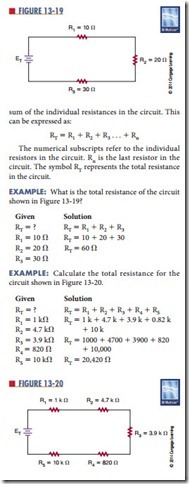connecting Resistors in series
A series circuit contains two or more resistors and pro‑ vides one path for current to flow. The current flows from the negative side of the voltage source through each resistor to the positive side of the voltage source. If there is only one path for current to flow between two points in a circuit, the circuit is a series circuit.
The more resistors connected in series, the more opposition there is to current flow. The more opposition there is to current flow, the higher the resistance in the circuit. In other words, when a resistor is added in series to a circuit, the total resistance in the circuit increases. The total resistance in a series circuit is the
Related posts:
SYNCHRONOUS MACHINES:PHYSICAL DESCRIPTION
CONVENTIONAL D.C. MOTORS:SHUNT, SERIES AND COMPOUND MOTORS
The Capacitor-Start Motor
Power Supply Design:High Power Systems
Burned Windings from Operating on Single Phase
Solid-State Dc Drives:Current Limit Control
Safety:Preventive Measures
STEPPING MOTORS:STEADY-STATE CHARACTERISTICS – IDEAL (CONSTANT-CURRENT) DRIVE
TIMED STARTING FOR THREE MOTORS
Electric Motor Manual – INSTALLATION METHODS – Motor retrofits to save over $2-million
Video Synchronization:Analogue Video Interfaces
Digital Audio Fundamentals:Time Compression and Expansion
Microphone Technology:Microphone Connectors, Cables, and Phantom Power
Signal-carrying switches:Digital switching
